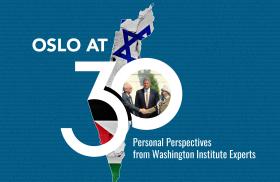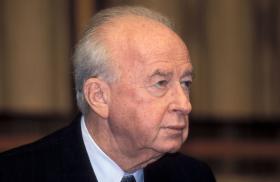
- Policy Analysis
- Fikra Forum
Oslo at 30-A Personal Perspective

Part of a series: Oslo at 30
or see Part 1: Oslo at 30: Personal Perspectives from Washington Institute Scholars A Compendium
The Oslo Accords were seriously flawed but now must be preserved. Some of the mistakes can probably be fixed over time to make sure the historic agreement does not remain a breakthrough into a dead end, but instead paves the way towards a stable compromise between Israel and the Palestinians.
The main dilemma faced by Israel in its pursuit of coexistence with the Palestinians was whether to seek a deal with the “resistance,” then the PLO but Hamas today, or to instead reach out to the local population that had grown accustomed to dealing with Israel for the last 56 years. Invariably, all Israeli leaders up to now have refused to bet on the Palestinians living next to us. Honest disclosure: my entire career has been spent in the no man’s land between Israelis and Palestinians. As a supporter of the two-state vision, I have always felt that the road not taken offered better prospects of success.
As a young junior assistant at Defense Minister general Moshe Dayan’s office in the aftermath of The Six Day War, I was a witness to a still unpublicized and short-lived initiative undertaken by a handful of Mossad operatives to explore the prospects of promoting the establishment of a Palestinian state sponsored by Israel. Numerous conversations with local leaders, along with some businessmen and academics in the West Bank and Gaza Strip, yielded an impression that Israel could prudently try to press forward in this direction, even as all the Arab states were bound by the Khartoum Summit’s rejection of negotiations for peace. Few Palestinian activists were loudly in favor of this idea pursued by the Mossad, although Yasser Arafat—who sneaked into the West Bank under different pseudonyms—was striving to build a Fatah-led armed underground to wage a “Popular Liberation War”.
Yet by April 1968, Dayan decided to drop the experiment. He did not have confidence in the local leadership’s ability to face both the radical Palestinian factions and president Nasser of Egypt’s opposition. Thus, the first opportunity to strike a partnership deal with our neighbors was not even tested. What followed was an ever-increasing pace of Jewish settlements and waves of terror attacks.
The second window of opportunity opened in the wake of the peace treaty between Israel and Egypt (1979). Ministerial delegations of both governments held talks with active U.S. mediation through August 1982 aiming at establishing “Self-Rule” (often defined as “autonomy”) for the Palestinians. Cairo quietly kept the PLO informed, although Arafat had rejected the Camp David Accords (1978) that had outlined the concept.
After the suspension of these efforts, no attempt was made to fully analyze this process and the protocols with the draft proposals were never published. Even so, I had covered these negotiations closely for my TV network, shuttling between Alexandria and Herzliya, and had a number of off-the-record discussions with President Sadat and his team as well as with the Israeli participants. I was convinced then—and now—that an agreement initially bypassing the PLO could have been within reach, allowing the Palestinians in the West Bank and Gaza strip to gradually assume the administration of these territories. Yet Prime Minister Begin, who has introduced this concept, was not truly interested in implementing this solution and the Egyptians did not exercise real pressure to move forward. Prior to his assassination in October 1981, Sadat told me privately: “Israel has chosen the Palestinians outside over those next to it.” Dr. Butrus Ghali, former UN Secretary General, likewise said to me: ”you are voting for Arafat!” That was the end of the “Self-Rule” option.
The outbreak of the first intifada in December 1987 offered a different path. Within days after the eruption of a massive uprising that took the PLO completely by surprise, Palestinians had formed a “Unified Command” comprising of all political factions to guide the strikes, demonstrations, and “Days of Rage” via circulating leaflets. Members of the different incarnations of the “Unified Command,” who were regularly rounded up by Israeli security, kept some contact with the PLO headquarters in faraway Tunis but ran the operation on their own.
As a journalist then spending much of my time in the field after writing the first book on Fatah, Prime Minister Rabin used to frequently invite me to review the rapid chain of events then unfolding. My advice to the beloved statesman was always the same: let’s talk to the “Unified Command”—both those behind bars and those who are free. Let them handle relations with Arafat and check whether an outline of a new arrangement is possible.
By August 1, 1989, The Washington Institute has published my paper “Toward Israeli-Palestinian Disengagement,” which encapsulated the recommendations I had been suggesting to Rabin. Yet Rabin remained skeptical about the freedom of maneuver of the local leadership. He would not adopt my prescription from that period: ”The initiative would involve Israel's administrative disengagement from the territories following a series of narrow agreements with local Palestinian bodies. Institutional disengagement would end a situation in which the weakened Israeli Civil Administration and the PLO-affiliated Unified Command's shadow administration coexisted in the midst of confrontation. If elections do not take place, this process would bestow control over aspects of autonomy upon those Palestinians who would win elections were they held. Some of the burden of occupation would be removed, Israeli-Palestinian friction would hopefully be reduced and a new channel for negotiations would be opened.”
Arafat was, of course, bent on preventing any progress towards this course. After the left-leaning Haaretz published a lengthy interview with me about these ideas, he sent messages reprimanding me and instructed his envoys in Cairo to sit with me and deliver his objections. The message was blunt: no deal without the PLO! Those meetings and many later ones with Arafat and his lieutenants were held in secret and never reported, since in those days my TV network forbade any contact with PLO affiliated officials.
By August 1993, a very reliable source told me that Rabin was going to accept a “Gaza-Jericho Deal” with the PLO. I did not believe Rabin would allow Arafat to enter the land. Together with my close friend, the late Ze’ev Schiff, we rushed to see the Prime Minister arguing that—as I had just written in a Jerusalem Report—“PLO? Not Now, Not Never.” Rabin neither denied nor confirmed the deal, shifting the conversation instead to other hot button issues. The result was that I went, as planned, to Washington DC to cover the next round of Israeli-Palestinian talks ignited by the Madrid Peace Conference. For the first time, Rabin had agreed that Faisal al-Husseini, the most prominent east Jerusalem leader, would be able to join in. I was not aware of the fact that across the Atlantic, the Oslo deal was about to happen.
Once the news of the agreement broke, few details were released. So—startled as I was—I began calling my PLO contacts in Tunis. Mahmoud Abbas (Abu Mazen) told me right away that the seven brigades of Fatah and the Palestinian Liberation Army would be deployed in the West Bank and Gaza Strip during the first phase. In other words, Arafat was invited right from the start to impose full and exclusive control over the local Palestinian population. He was granted the armed forces, generous funding by international donors, and a free ticket to bring with him PLO’s culture of terror campaigns, corruption, and devotion to “liberate Palestine.” Old friends from the Palestinian territories were calling me hoping to hear this would not be the case. Yet it was!
Arafat and his entourage were allowed to enter Israel in July 1994. When his convoy arrived from Egypt to the Rafah crossing, the Israelis quickly discovered that he was trying to smuggle in three major terrorists who Rabin had instructed him not to bring until further consultation. In fact, Arafat was sitting on one of them—Jihad Amarin—in the back seat of his black Mercedes. The second fellow was hiding in the boot and the third in the next car. Arafat claimed it was “misunderstanding.” This moment was the real inauguration of the implementation of Oslo.
On September 13, before the signing ceremony of the accords at the White House, I had an exclusive live interview with Arafat at his hotel. After years of monitoring him, exposing his true name and biography, he sounded too cautious to celebrate peace and too vague about his vision for me to be confident in his intentions. At that time, I was broadcasting on the only TV channel in Israel, covering the South Lawn signing ceremony and speeches. I was vehemently criticized the next day by Israeli media and by family and friends alike for being “sour” in my coverage. An hour later, after an Oval Office interview, President Clinton asked me why I was so skeptical. My answer was that I had not heard from Arafat what I had heard years before from Sadat: “No more war, no more bloodshed!”
It was clear to me then and remains so: Arafat signed the Oslo accords to gain a foothold in the land. He had never considered a long-term compromise, giving up the Right of Return or divorcing “Armed Struggle.” For him, it was no more than an armistice for a limited period. By 1995, he has signaled to Hamas—according to its top leaders—that they could resume suicide bombings. He made sure his security agencies did not attempt to crush the terrorist attacks. Instead, they would arrest suspects and quickly release them through a “revolving door” model. The Palestinian National Authority established under the terms of Oslo came to be entirely dominated by the PLO returnees. None of the members of the Unified Command were nominated to a senior position. In fact, almost all of them retired from politics and a significant number left the country to live abroad.
By that summer, Rabin reached the conclusion that Arafat was cheating. He told Dr. Henry Kissinger—as the legendary former Secretary of State disclosed to me later in New York—that he intended to opt for a “reassessment” of the Oslo process. Rabin shared his disappointment with a handful of close security advisors, confiding in them that he was going to serve Arafat with “a bend or break” ultimatum: curb the terror attacks or Israel will review its commitment to Oslo. They advised him to wait until after the first Palestinian general elections on January 25, 1996. The meeting between the two leaders was scheduled but did not take place—On November 4, 1995, Rabin was assassinated in Tel Aviv. His successor, Shimon Peres, was keen on maintaining the Oslo process as it was.
Since then, all efforts to revive Israeli-Palestinian negotiations, reduce the volume of violence—which peaked during the Arafat-inspired second intifada (2000-2003)—and build the PA into an effective vehicle for diplomatic engagement and economic and social services have ended in failure. The PA lost Gaza to Hamas in 2006 and is currently losing its control in several parts of the West Bank. It has become extremely unpopular amongst Palestinians and mainly operates as a patronage system to employ an ever-expanding public sector.
By now, the preservation of the PA as a potential partner for peace with Israel in the future requires an ambitious reform, replacing the PLO old guard who still maintain control with true representatives of the local population. The international donor community and the Gulf states, with Israeli support under a different coalition, can exercise influence to bring new figures to leadership positions. These figures can in turn prepare the West Bank for whatever type of statehood with limited sovereignty may hopefully emerge from a potential fresh dialogue with Israel. Of course, such an endeavor will prove pointless as long as far right wingers seeking annexation remain an important part of the Israeli government. The Oslo Accords should not be discarded but corrected to serve as the foundation of a reinvigorated political platform. An overhaul of the security organs is imperative, as are investments in infrastructure. The division to zones A, B, and C should be revised and the Paris Protocol on the economic aspects deserves an update.
As Rabin came to realize that the PLO was not the best counterpart, so should we now: the PLO has degenerated since Oslo and lost its strength. There are strong—though mostly silent—forces within Palestinian society eager to serve their nation, who are disenchanted with “armed struggle” and who believe that cooperation with Israel is their preferred course. We had better give them a chance and a helping hand.






